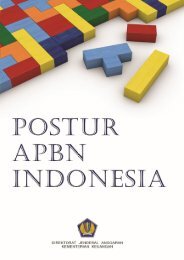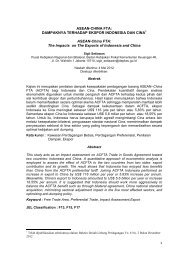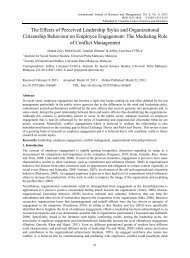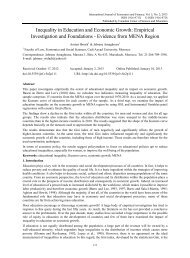Marketing%20Strategies%20and%20the%20Difference%20Level%20of%20Sales%20and%20Profits
Marketing%20Strategies%20and%20the%20Difference%20Level%20of%20Sales%20and%20Profits
Marketing%20Strategies%20and%20the%20Difference%20Level%20of%20Sales%20and%20Profits
You also want an ePaper? Increase the reach of your titles
YUMPU automatically turns print PDFs into web optimized ePapers that Google loves.
www.ccsenet.org/ijbm International Journal of Business and Management Vol. 7, No. 23; 2012<br />
4.3 Discussions<br />
In this section, the findings which obtained from section 4.2 were discussed. Each variable and its finding were<br />
separately discussed in each sub-section.<br />
4.3.1 Sales Made Directly to the Customer and Different Level of Performance<br />
The findings from this study showed that there were no differences in the number of sales made directly to the<br />
customers between high and low performance of batik SMEs in Malaysia under both performance measures. This<br />
means that the number of sales made directly to the customers was not differ between high sales performers and<br />
low sales performers. This also means that there were no differences in the number of sales made directly to the<br />
customers between high profits performers and low profits performers<br />
The findings of this study is contrast to the study by Siu (1999) which found that high performing firm was less<br />
involve in personal selling. The reason of the contrast finding may be due to lack or unclear target market among<br />
batik SMEs. They might identify the general public as their markets. The target market was not well defined<br />
because products were made for any interested customer. This might be the reason as noted by Shim and Drake<br />
(1991), lack of information about target market is a major problem among small firms.<br />
4.3.2 Out-of-state Sales and Different Level of Performance<br />
In term of out-of-state sales, the results indicated that there were differences in this variable between high and low<br />
performance of batik SMEs in Malaysia. This difference was appeared under both sales and profits performance<br />
measures. This means that the number of out-of-state sales was differed between high and low sales performers. It<br />
means that the number of out-of-state sales made by high profits performers was also differed from the low profits<br />
performers.<br />
High performers were expected to have broader target market than the low performers. This findings support the<br />
expectation when the results showed that the mean rank of high performers which marketed products out-of-state<br />
sales was greater than those of low performers. This finding is in agreement with the study by Siu (1999) which<br />
found that higher performing firms tend to use market expansion as their marketing strategies. However, the<br />
finding in this study was contrast to the finding in Chaganti and Chaganti (1983) study which found that the<br />
profitable firms concentrated on local markets while the less profitable firms tended to serve mostly regional and<br />
national markets – markets far from plant locations.<br />
4.3.3 International Sales and Different Level of Performance<br />
The data analysis showed that there was no difference in the number of international sales between high and low<br />
performance of batik SMEs in Malaysia under both performance measures. This means that the number of sales<br />
made at international level was not differ between high sales performers and low sales performers. The number of<br />
international sales was also not differed between high profits performers and low profits performers.<br />
From the descriptive statistics results, only 19.3% of batik SMEs in Malaysia were involved in international sales.<br />
Conclusion can be made that batik SMEs in Malaysia are still not ready since many SMEs respondents are much<br />
more rely on domestic sales. This finding is in agreement with the study by Durham and Littrell (2000). Study by<br />
them on handcraft producers in 11 developing countries indicated that it was hard to reinforce international market<br />
because of time constraints, labor constraints and transportation constraints. Accepting these constraints, the<br />
entrepreneurs emphasized market diversification by concentrating on local and national rather than international<br />
sales. Therefore, Durham and Littrell (2000) concluded that marketing internationally was not always desirable<br />
and possible for the handcraft industry.<br />
4.3.4 Advertising and Different Level of Performance<br />
The finding concluded that there were differences between high and low performance of batik SMEs in Malaysia<br />
in term of frequency of advertising. However, the difference occurs only under sales performance measure but not<br />
under profit performance measure. This means that the attention is given on advertising of high sales performers<br />
were differed from the low sales performers. This result is consistent with the suggestion by Lincoln and Naumann<br />
(1986) in that advertising plays a critical role in the success or failure of many small businesses.<br />
As stated previously, the difference however only exists between high and low sales performers but not between<br />
high and low profit performers. Therefore, regarding profit performance, this study is in agreement with De<br />
Carolis (2003) study in US which found that advertising is not significantly related to profitability. In addition to<br />
that, Fillis (2004) study also agreed that advertising was not an option for many craft firms. His study on smaller<br />
crafts firm in the UK found that instead of using advertising tools, the entrepreneurs prefer to use a combination of<br />
107









